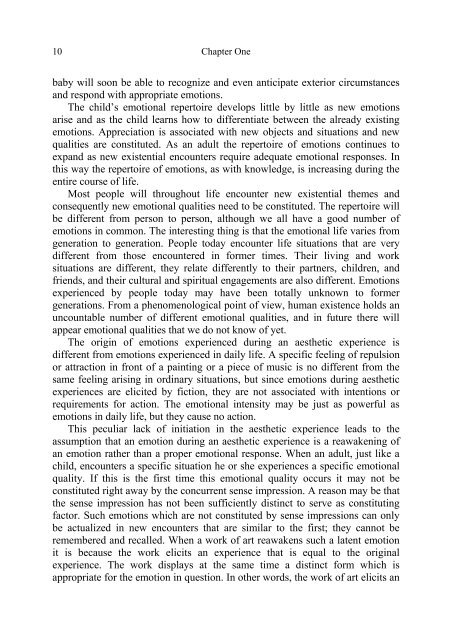Aesthetics and Innovation - Cambridge Scholars Publishing
Aesthetics and Innovation - Cambridge Scholars Publishing
Aesthetics and Innovation - Cambridge Scholars Publishing
Create successful ePaper yourself
Turn your PDF publications into a flip-book with our unique Google optimized e-Paper software.
10<br />
Chapter One<br />
baby will soon be able to recognize <strong>and</strong> even anticipate exterior circumstances<br />
<strong>and</strong> respond with appropriate emotions.<br />
The child’s emotional repertoire develops little by little as new emotions<br />
arise <strong>and</strong> as the child learns how to differentiate between the already existing<br />
emotions. Appreciation is associated with new objects <strong>and</strong> situations <strong>and</strong> new<br />
qualities are constituted. As an adult the repertoire of emotions continues to<br />
exp<strong>and</strong> as new existential encounters require adequate emotional responses. In<br />
this way the repertoire of emotions, as with knowledge, is increasing during the<br />
entire course of life.<br />
Most people will throughout life encounter new existential themes <strong>and</strong><br />
consequently new emotional qualities need to be constituted. The repertoire will<br />
be different from person to person, although we all have a good number of<br />
emotions in common. The interesting thing is that the emotional life varies from<br />
generation to generation. People today encounter life situations that are very<br />
different from those encountered in former times. Their living <strong>and</strong> work<br />
situations are different, they relate differently to their partners, children, <strong>and</strong><br />
friends, <strong>and</strong> their cultural <strong>and</strong> spiritual engagements are also different. Emotions<br />
experienced by people today may have been totally unknown to former<br />
generations. From a phenomenological point of view, human existence holds an<br />
uncountable number of different emotional qualities, <strong>and</strong> in future there will<br />
appear emotional qualities that we do not know of yet.<br />
The origin of emotions experienced during an aesthetic experience is<br />
different from emotions experienced in daily life. A specific feeling of repulsion<br />
or attraction in front of a painting or a piece of music is no different from the<br />
same feeling arising in ordinary situations, but since emotions during aesthetic<br />
experiences are elicited by fiction, they are not associated with intentions or<br />
requirements for action. The emotional intensity may be just as powerful as<br />
emotions in daily life, but they cause no action.<br />
This peculiar lack of initiation in the aesthetic experience leads to the<br />
assumption that an emotion during an aesthetic experience is a reawakening of<br />
an emotion rather than a proper emotional response. When an adult, just like a<br />
child, encounters a specific situation he or she experiences a specific emotional<br />
quality. If this is the first time this emotional quality occurs it may not be<br />
constituted right away by the concurrent sense impression. A reason may be that<br />
the sense impression has not been sufficiently distinct to serve as constituting<br />
factor. Such emotions which are not constituted by sense impressions can only<br />
be actualized in new encounters that are similar to the first; they cannot be<br />
remembered <strong>and</strong> recalled. When a work of art reawakens such a latent emotion<br />
it is because the work elicits an experience that is equal to the original<br />
experience. The work displays at the same time a distinct form which is<br />
appropriate for the emotion in question. In other words, the work of art elicits an

















